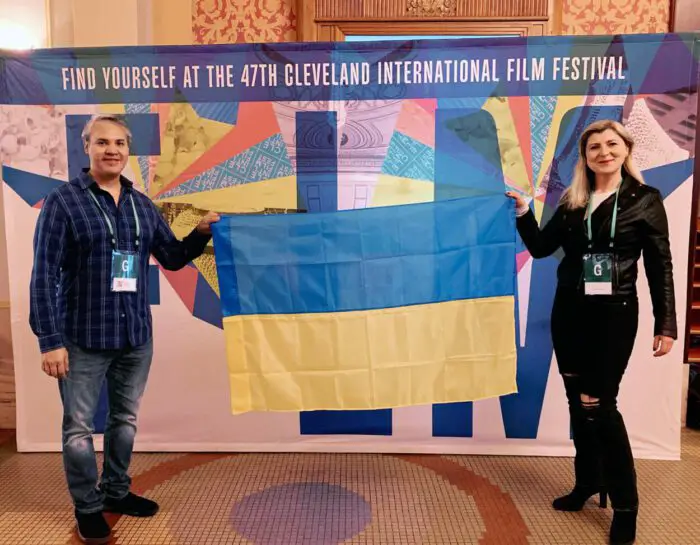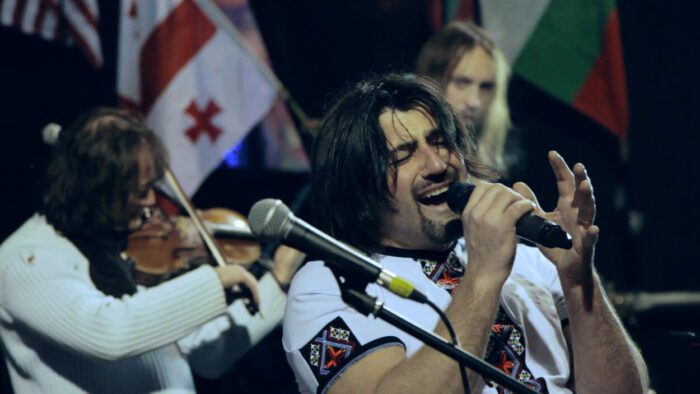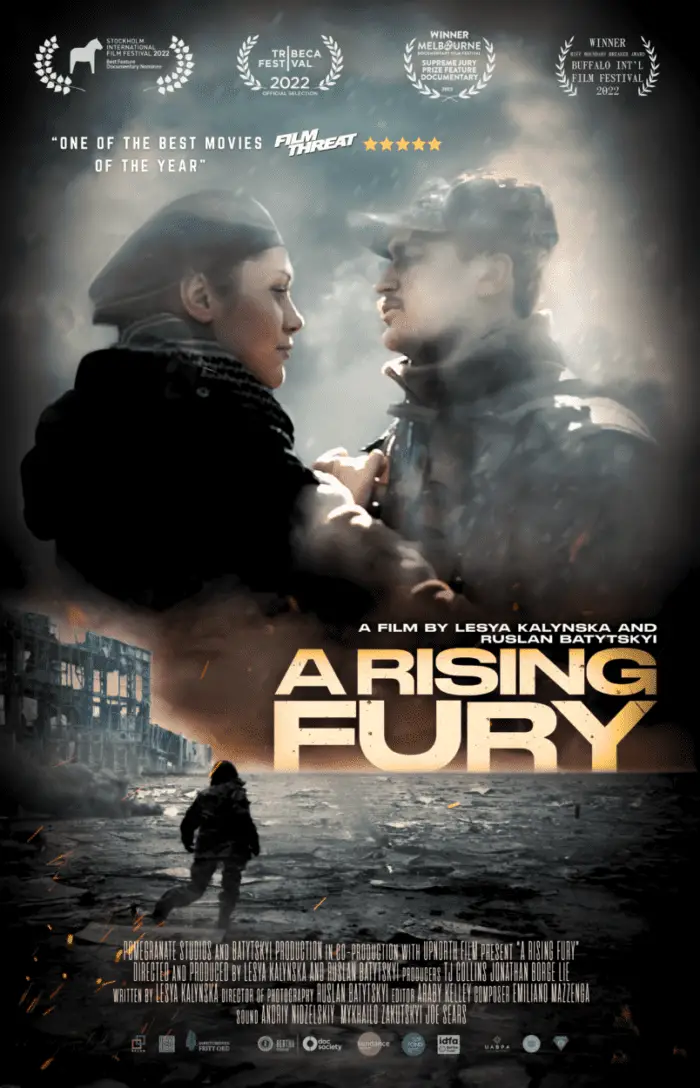For filmmakers Lesya Kalynska and TJ Collins of the documentary A Rising Fury, theirs is a passion project, the result of more than a decade’s worth of filming, planning, and editing documenting the war in Ukraine. It hasn’t been easy: shooting has been dangerous, the war ongoing, and the project’s editing complicated. But now, with their film in release, the two are proud of the film’s reception and looking very much forward to its continued distribution—as well as, it should not go unsaid, to freedom for the Ukrainian people.
A Rising Fury traces the seeds of the conflict from the events just preceding the Revolution of Dignity in 2014 to the 2022 full-scale invasion of Ukraine through two main characters: Pavlo Pavliv, a young Ukrainian who becomes a soldier and leader in their Armed Forces, and Svitlana Karabut, a charismatic young volunteer supporting the resistance effort. A Rising Fury traces their lives as Pavlo comes of age from a naive young man to a soldier who must fight for his country and he and Svitlana risk their lives—and their growing love for each other—during the war. Following its premiere at Tribeca Film Festival in 2022, A Rising Fury received further recognition, being nominated for best documentary and other top awards in nine international film festivals.
Lesya Kalynska is an award-winning Ukrainian-American director, producer, and screenwriter based in New York City. Born and raised in Kyiv, Ukraine, she holds a PhD in Literature and an MFA in film writing and directing from NYU’s Tisch School of the Arts. A Rising Fury, which she wrote, co-directed, and co-produced, is her first full-length feature documentary.
TJ Collins in an award-winning filmmaker with over a dozen films produced including short and feature narratives, among them his debut feature Willets Point (2010) and the narrative sports drama The Driven (2022). Collins has served as a peer judge for the New York Emmy Awards and is a member of the National Academy of Television Arts and Sciences, New York Chapter.
Kalynska and Collins just learned that A Rising Fury is eligible for Academy Award consideration when they recently took time from their busy promotional schedule to speak with Film Obsessive’s Executive Editor J Paul Johnson on the film’s origins, production, and reception.
Film Obsessive: Congratulations on the recent successes of your film A Rising Fury! The two of you have been very busy promoting it. Thanks for taking time to talk with us at Film Obsessive. How has the reception been for the film at your recent events?
Lesya Kalynska: It’s been incredible. Audiences are so moved by the film, and they connect with it in their own way. The film traveled all over the world for almost a year and a half on four continents including Australia and has received very positive reactions from audiences and film critics. It’s interesting to see how audiences from different countries react to the film, especially countries that share a border with the Russian Federation. They can relate to what Ukraine is going through and so it appeared to be more emotional for them. In the United States some people are so moved by the film that they have taken the initiative to organize the screenings of A Rising Fury in their own city or local university. With Ukraine disappearing in the news, we wanted to have a theatrical release devoted to the 10th anniversary of the Revolution of Dignity to bring various communities together and continue to raise awareness about the war in Ukraine.

The story told in A Rising Fury is a long and complicated one, but it’s presented with such economy it can serve almost as a primer for someone who knows little about the war. Lesya, you were born and raised in Ukraine; TJ, you are American, born in the United States: what’s it important for your viewers to understand about the war for independence there?
Lesya Kalynska: Some Americans are under the impression that this war started with the full-scale invasion in 2022 but that is not correct. It began in 2014 with the annexation of Crimea and continued with the invasion to Donbas in the Eastern part of Ukraine. So, the Russo-Ukrainian war has been ongoing for almost 10 years. But the struggle for freedom and true Ukrainian independence goes back in history to the 17th and 18th centuries when the Russian empire took over our lands which had strong democratic roots and even elected leaders at that time.
This current war is an existential fight. Ukrainians are literally fighting for their lives. But also, they are leading a battle between democratic and totalitarian systems. People in the west should understand that this is not some local conflict, but we are in this together. If democratic nations allow some aggressive country to illegally destroy another independent country—in my view, it will mean that international laws are no longer working. Americans should realize that if they don’t continue to help Ukraine win this war—eventually the conflict may involve Poland or the Baltic states to stop the Russian federation and American troops may be deployed as a part of NATO forces.
TJ Collins: I’m speaking as an American that has lived in Ukraine while producing A Rising Fury. There are several misconceptions that I would like for readers to understand. Ukrainians are not Russians. Although they speak fluently in Russian, their national language is Ukrainian and they are two completely different cultures and not “one people” as Putin claims. To this day Ukrainians are fighting for the same values that Americans fight for. They value the power of Democracy, Freedom, and Liberty. I’ve been asked many times why the United States is supporting Ukraine with weapons and funding, and I tell them that the US is responsible for Ukraine’s security.
As many know, after the breakup of the Soviet Union Ukraine had the third largest nuclear arsenal with 1,900 strategic nuclear war heads. It was in the interest of the US to reduce that stockpile and eliminate that threat to America. The 1994 Budapest Memorandum was an agreement by the United States, Great Britain, and Russia to respect the independence and sovereignty of Ukraine’s boarders with the understanding that the Ukrainian government give up its nuclear weapons, which it did. Obviously, Russia has broken that agreement, but there were assurances by the United States to provide security if Russia violated the memorandum. If the West does not continue to support Ukraine militarily, the country may cease to exist and its 43 million-plus citizens permanently displaced throughout the world.

Had you always intended to tell the story through these two main characters, Pavlo and Svitlana? Both make for excellent documentary subjects: they’re charismatic, courageous, intelligent, and articulate. How did you come to meet each of them?
Lesya Kalynska: At first, we followed many other very impressive people, even some Ukrainian celebrities, who took active part in the Revolution of Dignity. But it was very important for me personally to follow regular people in Ukraine, those who carried the hardest historic tasks on their shoulders. Their dramatic transformation was fascinating to me. We were immediately drawn to a couple who were members of self-defense units against hired thugs and special forces controlled by the corrupt, Russian-backed president Victor Yanukovych.
In terms of story, it wasn’t immediately clear to us that these two would be our main subjects in the film. We followed many interesting people during the revolution, around seven in total. Pavlo had a very interesting story because he was from the Eastern part of Ukraine. In 2014 Crimea was annexed and Donbas was invaded, including Pavlo’s native home city Donetsk. Our team continued to follow Pavlo in his quest to liberate his city. We ultimately filmed hundreds of hours of material for 10 years now, and we are currently filming in 2023.
Your footage of the war, from the opening carnage of the Donetsk airport battle to the 2022 invasion, is so immediate it caused me to worry for the camera operator’s safety! Can you speak to the camerawork we see—who shot the footage and under what circumstances?
Lesya Kalynska: Our team began filming in 2013 at Maidan, Kyiv’s Central square during the Revolution of Dignity and spent many days and nights there all the way until Yanukovych fled to Russia, and even a few weeks after. In November 2023 it has been exactly ten years since we began filming, and currently the team is still traveling with the film and promoting it. Our crew members had different life circumstances, and our project is rather epic; therefore, we had many cinematographers filming, including my co-director/DP Ruslan Batytskyi and myself. We filmed in very dangerous situations, including during the February massacre in Kyiv. Despite the danger, many talented filmmakers worked with us to document the war, so people around the world can see the truth and do something to stop these unspeakable crimes by the Kremlin’s regime.
The opening scene that you’ve mentioned, the Donetsk airport battle—was filmed by Lesko Kromplitz in 2015. He volunteered to go there and captured this historic footage. I’d like to acknowledge the very talented cinematographer Anton Fursa with whom we filmed a large part of the Revolution of Dignity. We also had strong work by cinematographers Ruslan Batytskyi, Anton Yaremchuk, Taras Tomenko, Taras Tkachenko who did a great job filming on the ground in Eastern Ukraine. Some of the unique footage was captured by Pavlo and other soldiers in locations where crew was not permitted. During the full-scale invasion in 2022, Ruslan and Ivan Fomichenko captured some incredible historic material in Kyiv’s region that was included in this latest version. For me, it took many years of traveling back and forth from the US to Ukraine to continue filming, including in 2022 and 2023, some of this footage we hope to incorporate in our new project.

Wow. With so many different people working to capture footage—a necessity of the project, I’m sure—it must have been difficult to manage the project! What was your own timeline of participation? Had the two of you both been working on it since the events of 2014-15? How long have you known each other and been collaborating?
Lesya Kalynska: I participated on the Revolution on Granite in 1990 and was fascinated by the resurrection of freedom and peaceful revolution becoming a space of creating visions for the future of an independent Ukraine. So, in 2013 when it became inevitable that Viktor Yanukovych was not going to sign the EU agreement and revolution was in the air, I went to Ukraine. I flew to Kyiv from NYC, where I lived at that time, and began arranging the film team and looking for funds. I’ve been working on making this film and promoting it ever since. It’s been exactly 10 years for me.
TJ Collins: I got involved as a producer on the film back in 2016, I met Lesya and Ruslan in NY at that time and they showed me some of their footage from the war. I was shocked to see tanks and firefights on battlefields like WW2. I just couldn’t understand how this was going on and I knew little about it. I knew there was fighting with Russian-backed separatists but nothing on this scale. How did the world not know this was happening? So, I did all that I could to help them tell this unbelievable story. Seven years later I’m still working to get this story out into the world.
And it is getting out! With the film including footage from events taking place over nearly a decade, organizing the project and editing it down to a 90-minute narrative must have been quite the challenge. Lesya, you are one of three credited editors. How do you manage the scope of the project?
Lesya Kalynska: First of all, the writing and editing process were closely connected and interwoven. Throughout the years we found that the story was changing, our subjects were changing, and we were changing. When you direct, write, and edit a film where the story and the war is ongoing it is incredibly difficult to organize and edit it down to about an hour and a half. The history is evolving all the time and so you must adapt and be open to making changes in the edit as new information comes in, so we had multiple edits. The first edits, for example, were about the revolution; in 2015 the cut was mostly about the war in Donbas; then we began to merge the two parts. One of the major cuts in 2019 that we did with Ruslan Batytskyi and TJ in Ukraine was broadly focused on different aspects of hybrid war and how it applied to our subjects. But it contained too much information, and it was too difficult for viewers to process.
So, in 2020 we started working on a new version tailored for western audiences. Pavlo began to reveal more about the hidden Russian strategy to subvert young Ukrainians to become separatists and fight for Russia against their own people. We found this strategy quite shocking, especially in the context of Kremlin’s propaganda that tried to portray their invasion and military aggression as a civil war in Ukraine. We decided then to focus on a deeper exploration of this unique story which we reveal in the film. It was challenging to merge the verité style with photographs, archive materials, maps, and graphics, but we felt that this was necessary to tell a personal story and articulate these hidden military strategies. Our U.S.-based editor Araby Kelley and TJ both played a huge role in creating the new cut. This last version was completed after the full-scale invasion and is presented in a way that audiences in the West can understand better.

I noted in my review that your doing so was nothing short of a “documentary miracle” in making sense of the conflict through the lives of Pavlo and Svitlana. I read that you have some 500 hours’ worth of footage. Are there plans for a sequel or docuseries?
TJ Collins: Yes, over the years we have accumulated a lot of filmed material. We have more of Pavlo and Svitlana’s journey over the years that we would like to expand into a docuseries. We also have many other people with incredible stories that we filmed and followed from the revolution in 2013 to the war in 2023. These stories didn’t make it into the final film because we were restricted with the film length and structure. So, we are currently developing this into a docuseries and looking for partners to help make it happen.
We’ll look forward to that! In the interim, what’s your greatest hope for the outcome of the film? And for your subjects—Pavlo and Svitlana and the people of Ukraine?
Lesya Kalynska: We feel that our film is very important, and we want as many people around the world to see it as possible. We also want the film to be accessible to a wider audience and especially students, not only now but also in the future so that they can research this period in history and hopefully have ways to respond to wars and reveal the hidden threats that they face in their time. For Pavlo and Svitlana to return from war and live normal lives. For the people of Ukraine its simple, live in their country without the occupation of the invaders and live as free people in a democratic society.
Thank you again for speaking with us at Film Obsessive. Our best wishes for the continued success of the film!

The festival and theatrical screening schedule for A Rising Fury can be found on the film’s website at www.arisingfury.com.




